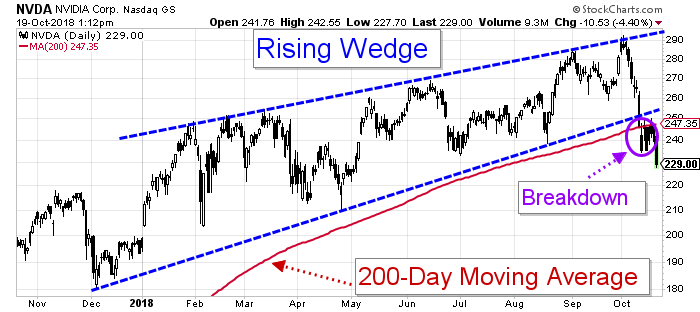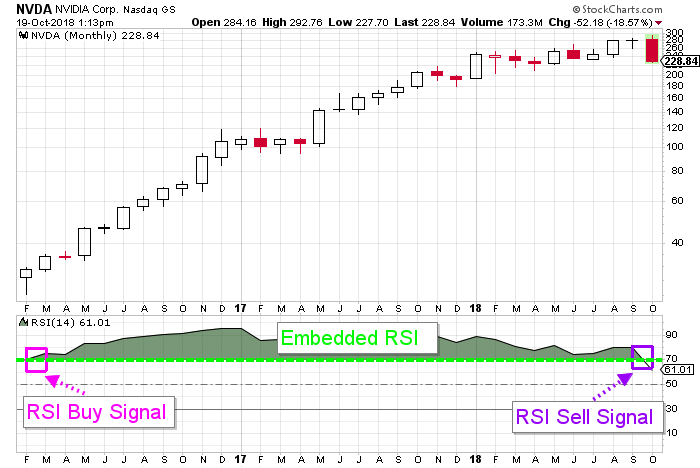These Indications Are Pointing Toward Lower NVDA Stock Prices
Marijuana Business, Stocks, Finance, & Investing October 23, 2018 MJ Shareholders 0


NVDA Stock: This Is Why Further Selling Is Expected to Follow
October is historically a bad month for stocks, and 2018 is no exception. I am focusing on NVIDIA Corporation (NASDAQ:NVDA) stock because the pillars of support that have been responsible for supporting NVDA stock in recent years have begun to crumble.
These pillars of support are a number of technical indications that have always suggested that NVDA stock was in a bullish state and, therefore, geared for higher stock prices.
The recent bout of market weakness has caused these technical indications to swing into a bearish state, suggesting that NVIDIA stock has not only peaked, but that a significant correction is likely to follow.
The first set of indications suggesting that NVIDIA stock has peaked and lower prices are likely to follow is captured on the following NVDA stock chart.
Chart courtesy of StockCharts.com
Since December 2017, NVDA stock has been carving out a price pattern known as a rising wedge.
This pattern is captured by connecting the peaks and troughs created by the price action. The end result is two converging upward-sloping trend lines.
One trend line represents a level of price resistance. The other trend line represents a level of price support. These two trend lines contain the stock price while the pattern is playing out.
In order to complete the pattern, the stock price needs to exit the pattern. On average, this pattern is resolved to the downside. It needs a constant flow of buying pressure to keep the stock price contained within the pattern. Any lack of buying pressure and the stock price will exit the pattern to the downside. This is why this pattern is also referred to as a “bearish” rising wedge.
On October 10, NVIDIA stock exited the rising wedge by breaking below price support. This event is suggesting that lower stock prices are now likely to follow.
What adds significance to this breakdown is that NVDA stock also broke below the 200-day moving average the following day.
The 200-day moving average is a popular metric used by traders and technicians alike. The 200-day moving average acts as a dividing line that separates stocks trading in a bullish state from stocks trading in a bearish state.
Deciphering between these two polar opposites is as easy as pinpointing which side of the 200-day moving average the stock is trading on. Trading above the 200-day moving average is a bullish indication. Trading below it is a bearish indication.
Breaking below the 200-day moving average is a very significant event, which is being amplified by the fact that NVIDIA stock has been trading above this metric for the last three-and-a-half years. The last time the stock price was below this metric was in the summer of 2015, when the stock was trading at $20.00.
The completion of the bearish pattern and the break below the 200-day moving average are suggesting that further losses are likely to follow. This notion that lower prices are on the horizon is being reinforced by the indicator highlighted on the following NVIDIA stock chart.
Chart courtesy of StockCharts.com
The focus of the NVDA stock chart above is the relative strength indicator (RSI), which is located in the lower panel.
The RSI is an indicator used to determine whether a stock is either experiencing overbought or oversold conditions. These extreme measures are determined using an oscillator that fluctuates between zero and a 100.
An RSI reading above 70 suggests that a stock is experiencing overbought conditions. An RSI reading below 30 suggests that a stock is experiencing oversold conditions.
Contrary to popular belief, just because a stock is experiencing an extreme condition does not necessarily mean that the stock is likely to move in the opposite direction. It’s quite the opposite, actually. As long as the RSI remains above 70 or below 30, it suggests that an accelerated move in that direction is likely to continue.
The chart above provides an excellent example of this extreme condition in action. In February 2016, the RSI registered a signal above 70, indicating that NVDA stock was experiencing an overbought condition.
The RSI remained embedded above 70 for the next 32 months. During that time frame, NVIDIA stock appreciated to the tune of 841.96%. This proves that just because a stock is experiencing an overbought condition, it does not necessarily mean that the stock price is going to correct. Instead, a stock can remain in an overbought condition for quite some time.
Only when the RSI returns from an extreme is a signal finally generated. For instance, when the RSI crosses above 70 and then crosses back below it, an RSI sell signal is created. When the RSI crosses below 30 and then crosses back above it, an RSI buy signal is created. In each case, the signal suggests that the trend that preceded it has run its course and that a new trend has begun.
The chart above illustrates that the recent bout of market weakness has caused the RSI to cross back below 70. This RSI sell signal is suggesting that the accelerated move toward higher NVIDIA stock prices that has been in development for the last 32 months has now come to an end. The ever-elusive correction that investors have given up looking for is now likely to unfold.
Analyst Take
I believe that NVIDIA stock is now poised to correct. My beliefs are based on a number of technical indications currently suggesting that NVDA stock is now geared toward lower prices. I will maintain a bearish view on this stock until there are indications suggesting that a bearish view is no longer warranted.
MJ Shareholders
MJShareholders.com is the largest dedicated financial network and leading corporate communications firm serving the legal cannabis industry. Our network aims to connect public marijuana companies with these focused cannabis audiences across the US and Canada that are critical for growth: Short and long term cannabis investors Active funding sources Mainstream media Business leaders Cannabis consumers












No comments so far.
Be first to leave comment below.